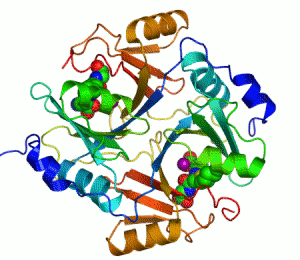Inhibition of enzymes
|
This article was marked by its author as Under construction, but the last edit is older than 30 days. If you want to edit this page, please try to contact its author first (you fill find him in the history). Watch the discussion as well. If the author will not continue in work, remove the template Last update: Sunday, 06 Nov 2022 at 1.59 am. |
There are many substances capable of disturbing with enzyme function in the sense of increasing ( activators ) or decreasing ( inhibitors ) its activity. The inhibition of enzyme activity is one of the most important regulatory mechanisms in living systems. The action of many drugs is also based on the inhibition of specific enzymes of metabolic pathways. Therefore, it is important to know the inhibitory mechanism of their action, which affects, for example, the possibilities of neutralizing their effect. Based on the reversibility of the effect , there are two main forms of inhibition: reversible inhibition or irreversible inhibition.
Reversible inhibition[edit | edit source]
Reversible inhibition can be suppressed. The inhibitor binds non-covalently ( by weak chemical bonds ) either to the active site of the enzyme or outside it. The effect of the inhibitor can be removed, for example, by increasing the supply of the substrate.
- Competitive inhibition
A competitive inhibitor competes with a substrate molecule for the enzyme's active site. These are often substances structurally similar to the substrate molecule, but incapable of undergoing an enzyme-catalyzed reaction – the inhibitor just binds to the enzyme. By increasing the concentration of the substrate, the inhibition can be suppressed by displacing the inhibitor from the active site. A competitive inhibitor does not affect vmax , it only delays its achievement (the inhibitor must be displaced by an increased concentration of the substrate). Thus KM increases (seemingly, the affinity of the enzyme for the substrate is reduced).
- Noncompetitive inhibition
In noncompetitive inhibition, the inhibitor binds outside the substrate binding site. This location is sometimes referred to as the modulation location. By binding, it changes the conformation of the enzyme in such a way that it also affects the conformation of the active site. This prevents binding of the substrate. Inhibition cannot be suppressed by increasing the concentration of the substrate, because the substrate has no tendency to bind to the modulatory site (so there is no fight - competition for the binding site). This inhibition can only be reversed by removing the inhibitor (e.g. dialysis). Since none of the enzyme-inhibitor complexes (or even enzyme-inhibitor-substrate) is catalytically active, the total amount of enzyme available for the substrate is reduced. This will result in a reduction in max reaction. KM does not change in this case .
- Acompetitive inhibition
This is inhibition in which the inhibitor binds only to the enzyme-substrate complex . This creates a terciary enzyme-inhibitor-substrate complex. There is a decrease in vmax (occupied complexes are enzymatically ineffective) and KM , but their mutual ratio does not change. The inhibitor is very ineffective at low substrate concentration because it does not have enough ES(enzym-substrate) complexes to bind to.
Irreversible inhibition[edit | edit source]
During this inhibition, also referred to as irreversible , a covalent modification of the enzyme molecule occurs. The inhibitor binds covalently into or outside the active site of the enzyme, and therefore it is not possible to remove the inhibition (for example, by dialysis or by increasing the concentration of the substrate).
Examples include heavy metals (Ag+ , Hg2+ ,...) or organophosphates and their derived nerve gases such as sarin and tabun.
Another phenomenon described is inhibition by an excess of substrate . When the concentration of the substrate is too high, there is a fight for the binding site between its molecules. This is reflected in the graph by a slight decrease in max in the area of higher substrate concentration.


